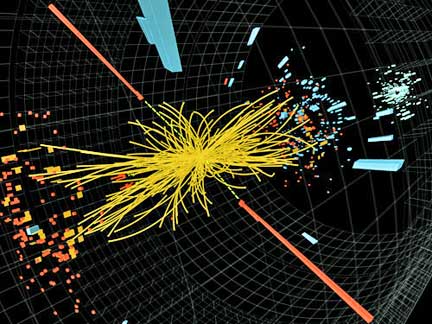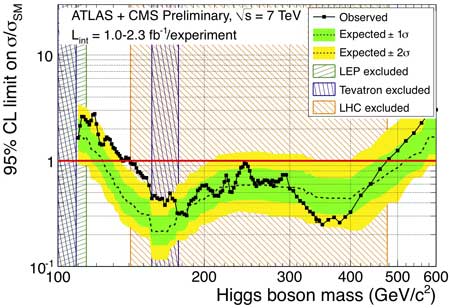January 11, 2012 -- Part 2
In Part 1 of this newsletter we discussed why theorists proposed the Higgs boson and what function they expect it to fulfill.
Now, how goes the experimental search?
Finding the Higgs boson was the primary
justification for building CERN’s $10 billion particle accelerator, the
LHC (Large Hadron Collider), near Geneva, Switzerland. The Higgs was so
intensely promoted that the media and public now await the “God
Particle’s” discovery almost as a Second Coming. Since the last major
U.S. particle accelerator was shut down in September, the LHC is the
only chance to find the Higgs. Over 5000 physicists from about 200
institutions and 40 countries are working on two detectors, ATLAS and
CMS, at the LHC. They have so far combed through 400 trillion particle
collisions, looking for something new. Below is a computer
reconstruction of the debris from one such collision, an “event”,
showing two high-energy photons (red lines) plus a myriad of other
particles.

Unfortunately, Higgs bosons do not have a
unique signature — they are thought to decay in many different ways,
all of which can occur through numerous Higgs-less processes. The only
hope is to look for a larger than expected number of certain types of
events, and see if these seem to come from a new type of particle, one
with a mass never seen before. All this is made far more difficult by
the complexity of events at this high energy, as seen above. In
December, ATLAS and CMS jointly published some tantalizing data, shown
below.

The mass of a potentially new particle
is plotted on the horizontal axis, and the number of events is plotted
on the vertical axis. The dark jagged line shows the number of observed
events, while the dotted line shows the number of events expected
without Higgs.
The data aren’t definitive. The data do
seem to have more events than expected at masses between 110 and 180,
which could be evidence for Higgs. But, there are also excess
unexplained events between 190 and 300, and more above 490. And there
are far fewer than expected events between 300 and 420; it’s very
difficult to explain finding fewer events than expected. I’ve seen
innumerable graphs of high-energy physics data — the most convincing
graphs showed data that nicely matched expectations from known processes
with an additional prominent spike in a definite position. These data
aren’t that convincing – at least not yet.
ATLAS and CMS will continue taking data.
With increased statistical precision, we hope the Higgs question will
be settled before the end of 2012.
If ATLAS and CMS don’t find the Higgs,
some Higgs enthusiasts will no doubt fall back on theorists’ favorite
refrain: “It’s really there, but just too heavy for current accelerators
to produce.” And, even if scientists prove the Higgs does not exist,
have no fear — particle masses will not disappear. Nor will theorists be
at a loss for other explanations. Numerous Higgs-less theories abound,
including: “technicolor”; extra dimensions with five-component gauge
fields; Abbot-Farhi composite vector bosons; top quark scalar
condensates; and a “braid model” compatible with loop quantum gravity.
Don’t ask.
If ATLAS and CMS do find the Higgs, a
whole new field of research will open: unraveling all its properties,
including why it interacts so differently with each of the currently
known particles. This could develop into a great discovery, and perhaps
even live up to its hype.
Part 1 is available on my website.
------------------------------------------------------------------------------------------------------------------

Dr. Robert Piccioni
www.guidetothecosmos.com
Author of "Everyone's Guide to Atoms, Einstein, and the Universe",
"Can Life Be Merely An Accident?"
& "A World Without Einstein"

|